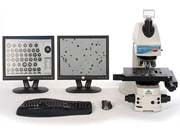Malvern Instruments has introducing the Morphologi G2 high-sensitivity particle image analyzer. Based upon digital image analysis and automated microscopy, the Morphologi G2 is dedicated to measuring both particle size and particle shape.
Using Nikon CFI 60 optics and a high-resolution, high pixel-density digital FireWire camera, the Morphologi G2 provides the highest quality, aberration-free images, according to the company.
The Morphologi G2 image analysis system measures:
Particle size: using different magnifications to ensure high resolution throughout the full particle size range (0.5µm 3000µm) the image analysis system accurately measures particle size using the circle equivalent diameter parameter.
Particle shape: a range of particle shape parameters such as elongation, circularity and convexity are calculated. These parameters allow subtle differences between samples that would be otherwise invisible to particle size-only techniques, to be identified and quantified.
Particle count and foreign particle detection: the fact that each and every particle in the sample can be individually measured and recorded enables the image analysis system to count certain types of particles - for example for the purposes of foreign particle detection.
The Morphologi G2 particle image analyzer provides microscope-quality images and statistically significant histograms providing the user with both qualitative and quantitative image analysis.
The Morphologi G2 image analysis system at a glance:
- Statistical significance: analyze 100s of thousands of particles with a single click of the mouse!
- No more user bias: the Standard Operating Procedures (SOP) approach allows all instrument variables (focus, light intensity, magnification etc) to be objectively recorded and controlled. Methods developed on one instrument can then be transferred electronically around the globe in a single file.
- Save high quality images: the ability to see and record an image of every individual particle enables a visual verification of phenomena such as the presence of broken particles, agglomerates, fines, foreign particles etc.
- Accurate, repeatable and validatable: to ensure data integrity the image analysis system automatically calibrates before and after every particle analysis using a multi-pitch grating traceable to NPL (the National Physical Laboratory). The image analyzer conforms to 21CFR part 11 requirements and full IQ/OQ (Installation Qualification/Operational Qualification) documentation is available.





